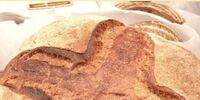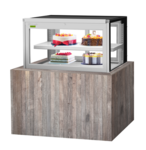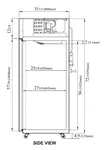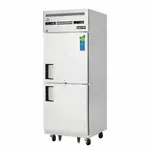Cake storage makes up an important part of storing desserts you offer at your bakery, cafe, or restaurant. Irrespective of its components, storing cakes makes them last longer, cutting down losses and wastage. Whether the cakes are iced, topped with cream, cream cheese, or fondant, refrigerators and bakery display cases can come in handy for cake storage. The guidelines for storage vary slightly based on the material, type, and size of the cake. Most techniques center around retaining moisture and texture within the cake as the process tends to dry out the sponge and harden the icing. If you're wondering how to keep cakes fresh, we have easy and simple tips to help you store cakes so they remain fresh and consumable no matter what your storage options are. Read on as we discuss the best way to store a cake, helping you retain freshness and taste in every slice you serve.
Do You Need a Refrigerator?
Most cakes that aren't iced or frosted will last nearly five days without refrigeration. However, cakes that contain fruit extracts, fruit pulp, mascarpone, icing, cream, buttercream, cream cheese, or dairy additives require refrigeration to keep them fresh. This need for refrigeration in cake storage is exacerbated during hot and humid months as the action of microbes is markedly higher during these times in the year. Most of these cakes can be stored for up to a couple of days. All cakes with icing or frosting should be allowed to return to room temperature and only then should you serve the cake.
It's important to keep in mind that storing cakes iced with fondant does not require refrigerators as the cold temperatures can make the texture flaky and irredeemable. Refrigeration also makes artificial colors bleed from fondant-based cakes, and must be avoided. If you have uniced cakes like spongecakes, it's better to store them in airtight containers or cake tins that have been prepared with non-stick baking paper. The airtight containers prevent moisture loss and are one of the best ways to store a cake. The enclosed casing also prevents the cake from absorbing flavors present in the freezer. To avoid your cakes from absorbing flavors from a common freezer, a viable solution would be to place them in a refrigerated display case, bakery display case, or a reach-in freezer as they exclusively hold cakes and desserts.
Storing Cakes Based on Size of Serving
Subtle changes in technique are integral to storing cakes that are either sliced, halved, or full-size. Icing and other forms of frosting also factor into storing cakes of different sizes. Here are different sizes and how you can store such cakes:
Sliced & Halved Cakes Without Icing: Slices from cakes without icing can be placed in airtight containers. To save space and place more slices in the same container, you can place a sheet of baking paper over the first slice followed by another slice or layer of cake. This prevents the bottom layer from drying out. Seal the container and these halves or slices can be stored for over 5 days.
Full-size Cakes Without Icing: Full-sized cakes that aren't frosted or iced can simply be placed in air-tight containers for storage. They last nearly a week and can be decorated after returning them to normal temperature.
Full-sized & Sliced Cakes with Icing: Cakes that have been iced prevent the sponge layer underneath from drying out by locking in moisture, however, these cakes are still vulnerable to absorbing different flavors and texture loss. Whether the iced cake is whole or halved, you can place toothpicks around the circumference to support plastic wrap. A couple of layers of the wrap should do well to lock in texture and avoid flavor transfer. Cakes that have fresh fruit components, dairy components, or syrup in their frosting layer, can be stored in airtight containers until serving.
Wrapping can Help
When you have cupcakes, muffins, and smaller sponge-based cakes, wrapping them with baking paper can help retain texture and moisture during refrigeration. All sponge cut sides must be wrapped in either plastic wrap or paper to keep out other flavors. You can also choose to store them in airtight containers in non-refrigerated cabinets, however, this reduces the period of cake storage.
Cake Freezing for Longer Storage Times
If you've been looking for answers to how to keep cakes fresh, you can extend a cake's shelf life by freezing it. Freezing for cake storage can help you retain cakes for up to 4 months. Freezing stops all microbial processes and locks in all the texture and moisture for the period that a cake is stored for. However, cakes with cream-based frosting don't last as long and shouldn't be frozen for more than a week as dairy tends to go bad in short durations. The methods of freezing vary for cakes that have icing and cakes that don't. Here's how you can freeze cakes:
Cakes Without Icing: Unfrosted cakes can be stored in either plastic wrap or airtight containers before freezing. The frosting material can be placed in Ziploc bags for freezing. This ensures both materials last longer and gives you an ingenious solution for cake storage.
Cakes with Icing: Like the refrigeration method, cakes that have icing can be wrapped with plastic wrap supported by toothpicks. This plastic layer can then be wrapped in aluminum foil before placing the cake in an airtight container or cake tin, giving the slice an added layer of protection.
Defrosting & Serving
Make sure all cakes that you store return to room temperature before you serve them to your customers. All sponge bases must be re-leveled following the freezing & thawing process due to potential expansion. Any frosting and icing that's been frozen must be whisked with tepid milk to bring them back to working consistency.
Important Tips & Guidelines
Here are some final pre-freezing and pre-refrigeration tips for both whole, halved, and sliced cakes:
Always cool cakes to room temperature before placing them in the freezer as moisture and humidity can condense and make the bottom layer of the cake sodden.
Make sure no cake is in a warm environment or under direct sunlight before refrigeration as this can melt or tarnish the frosting, fondant, or food coloring, giving you a messy product. This is especially important in the warmer months of the year as most cakes must be refrigerated during summer.
Never add frosting to warm cakes as the internal heat can melt the frosting, leading to a soggy and wet product that's unenticing and unattractive. Freezing such a product will cause a loss of texture and result in a cake that's brittle.
Use dedicated bakery display cases, refrigerated display cases, and reach-in refrigerators as much as possible for cake storage. Suppose you don't have access to these, make sure you have a neat and ordered freezer and refrigerator, and make sure no weight is placed above the cake or the container with the cake.
You can test a slice of your cake by storing and thawing it out to judge how the cake takes the rigors of storage. There exist a variety of refrigerator and freezer-friendly restaurant dessert recipes you can explore and implement in your menu for ease.
















